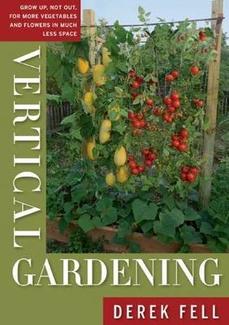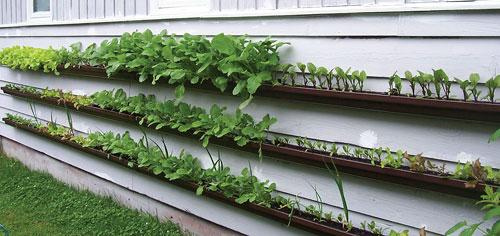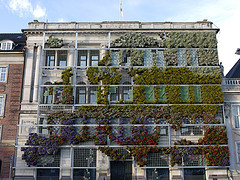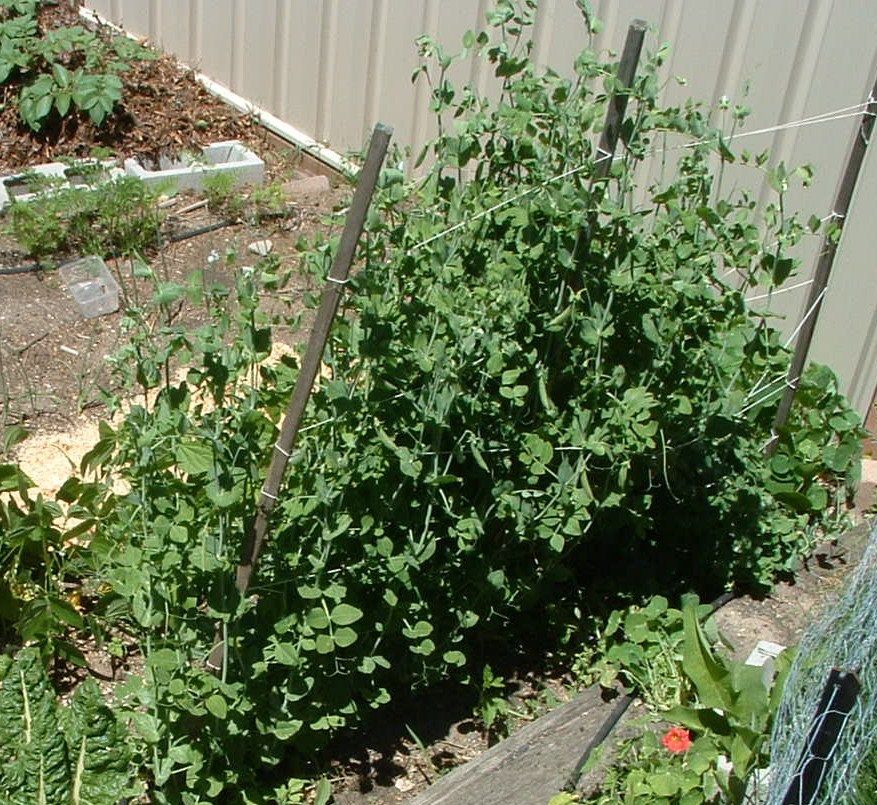Vertical gardening is just plain trendy right now, and it’s definitely a trend worth considering. If you’re green as well as green fingered (and I’m guessing as you’re on Sustainable Suburbia that’ll be about right!) this method of food growing will suit you (up and) down to the ground.
The carbon footprint of this type of cultivation is comparatively small as the required garden or allotment space is very much reduced, thus cutting down on watering, fertilisation and plant tending, and producing a greater crop to land ratio. Basically, you don’t need strips of land between each row of vegetables to navigate around your beds, as you would with traditional food growing. Vegetables grown in an up and down direction have access to greater air circulation, and particularly if you harvest the fruit regularly, they will keep on producing healthy, abundant crops.
 Vertical vegetable gardening ideas are as wide as your own imagination. From the simple methods of training vine vegetables like cucumbers up against a fence or trellis and growing climbing flowers like roses and wisteria up an arch or pergola, to the more complicated construction of cages and tall, angular frames to support your plants. You can use canes, wooden and metal structures or willow and bamboo to make attractive and durable supports, with netting or wire grids attached. Vertical garden design is sure to engage your creativity, produce an abundant crop, and just be great fun!
Vertical vegetable gardening ideas are as wide as your own imagination. From the simple methods of training vine vegetables like cucumbers up against a fence or trellis and growing climbing flowers like roses and wisteria up an arch or pergola, to the more complicated construction of cages and tall, angular frames to support your plants. You can use canes, wooden and metal structures or willow and bamboo to make attractive and durable supports, with netting or wire grids attached. Vertical garden design is sure to engage your creativity, produce an abundant crop, and just be great fun!
How to Make a Vertical Garden
So how many ways are there to create a vertical garden: Well how long is a piece of string? Basically a vertical garden is the method employed to cultivate trailers and climbers in a vertical direction either from the ground up, or trailing down from hanging baskets or in pots standing on or against a wall.
Talking of string – this can be used to form a simple web or trellis for plants to climb, or it can be employed to tie vines around canes and supporting frames. Recycling is very on trend right now, and you can use everything from plastic bottles and cut off lengths of guttering to window boxes and even the kitchen sink to anchor your plants.
Vertical gardens work just as well inside as outside your home. The positioning of containers and plant pots in a grid formed by horizontal and vertical rows is a very basic vertical garden, and can be arranged against a window or a wall (both inside and outside the home). A very basic indoor vertical garden can be made by placing rows of herbs on glass shelves arranged one on top of the other against a sunny window. A kitchen window would be ideal.
Vegetables on the Vine

Traditional vine vegetables like tomatoes, cucumbers, squashes, peas and beans are ideal for vertical growth, and there are more exotic climbing varieties like okra. Many of these vegetables have very pretty flowers. Other low growing vegetables like lettuces and herbs can be lined along the base of a vertical garden in a narrow strip of soil. You can even place newspaper on top of the soil to cut down on weeds, then place mulch formed from leaves or kitchen compost in layers on top of the paper, to a depth of about 15 to 30cm (6 to 12″). This will create sufficient depth for climbing plant roots, and also provide a fertile medium in which to plant low growing plants, to form the base of the vertical garden.
This growing method keeps fruit off the ground away from insects, moulds and fungi, and makes harvesting much easier. Bending down is kept to a minimum, and the eye level appeal of pretty fruit and flowers is typical of a vertical garden.
Vertical Indoor Garden Kits
Simple indoor vertical gardens can be bought ready to put together – with a back panel and rows of small plant pots. Irrigation is integral to the design, with a reservoir to allow watering to continue when you are not around. Some kits come complete with a variety of frames, and are designed to keep water away from the wall. Wall mounted indoor vertical gardens can employ a drip irrigation system. You can also get free-standing vertical garden kits – The Urb Garden for example, by Australian student designer Xavier Calluaud, is like a small cupboard. It uses an irrigation system and an integral worm farm to fertilize the plants.
Gutter gardens

Rows of recycled guttering from builders yards or bought from DIY shops (though avoid PVC as it may contain lead which could enter the soil) can be attached to a sunny wall or the side of your house, one above the other. If you rent – check with your landlord first! Salad greens, herbs and even strawberries are ideal plants for this simple type of vertical garden and it makes great use of an otherwise unused space. Make sure you source two ends – one blocked off at the left and one to the right – so the pieces can be stuck together, creating a sealed unit.
Start by drilling drainage holes in the base of the guttering, about every yard or so. Water will work down from the top rows to the lower levels of gutters. Irrigation is essential for these plants, and this can be achieved the old fashioned way – with liberal use of a watering can – so make sure the guttering is not too high. Targeted watering is necessary with a gutter garden placed against a building, otherwise you risk water erosion and the creation of damp on your walls. Fill the gutters with good compost, and mulch the soil to keep it warm and deter weeds. You can also create a simple, vertical hanging garden using rows of guttering suspended with metal wire, or build a free standing gutter garden held up by wooden stakes.
Window Farms and Bottle Gardens
Vertical vegetable gardens placed against an indoor window are also known as window farms. Window farms are commercially available as kits and include planters, net frames, a reservoir and a pump. These gardens can be grown hydroponically. Grown without soil, the plants in a hydroponic system are watered and fed by means of a pump which forces water from the reservoir at the bottom of the garden to the top planters. Water and nutrients are then fed down, creating a self sustaining system.
For a really good DIY version, recycled clear plastic bottles are ideal for turning into indoor vertical window gardens. You can make your own window farm by removing the bottoms of bottles and arranging them in rows, suspended by wires. Each bottle drains into the one beneath. Bottles should contain good compost and an individual plant – salad plants or herbs are ideal. Take account of temperature when planting your bottle garden. If there is a heater beneath the window, use dry and heat loving plants. If it is fairly cold, then use plants that thrive well in draughty conditions.
Vertical Garden Design on a Grand Scale

Some modern architects are making use of building space to create vertical gardens which blanket the external sides of large scale constructions like car parks. Many are also making use of indoor vertical gardens to blanket walls in commercial properties with living plants that aerate and clean the air, as well as creating a beautiful green environment within the workplace.
Eileen O’Sullivan is an English freelance writer, who once lived in beautiful Sydney (sigh!), where her first son was born. She passionately enjoys contributing to global health – and grow-your-own is a perfect start to sustainable living!
For more vertical garden ideas, see Eileen’s article on growing drought tolerant herbs, for which she suggests a vertical wooden pallet garden!



Thank you for the article. The photo of the raised be is a great idea. I had not seen that yet. I wonder if it will have trouble with stability?
Hi! So sorry – only just saw your message!! (Scroll down Eileen!!)
In the raised bed/trellis pictured, the upright trellis is inbuilt to the rectangular structure, so this will avoid issues of instability.
Thanks so much for your appreciation of the article
Eileen
What about square foot gardening? I never tried it myself, but I heard good things about it.
I haven’t tried square foot gardening either. It’s a different thing, but another way to arrange yourself and just get started, even with only a small space.
It’s actually a cool and helpful piece of information. I am happy that you simply shared this useful info with us. Please stay us informed like this. Thank you for sharing.
I recently received an arctile from Porch.com regarding VERTICLE veggie/fruit gardens and have lost it..HELP!! Does anyone have a COOY of this to share I will be forever grateful!!
Thank you!
Beverly
8th April 2015…
At this time it looks like BlogEngine is the top blogging platform out there right now.
(from what I’ve read) Is that what you’re using on your blog?
Hello everyone, it’s my first go to see at this site, and post is actually
fruitful in support of me, keep up posting these types of articles or reviews.
Please take a look at http://www.biovertigo.it any comment will be really appreciated. tks